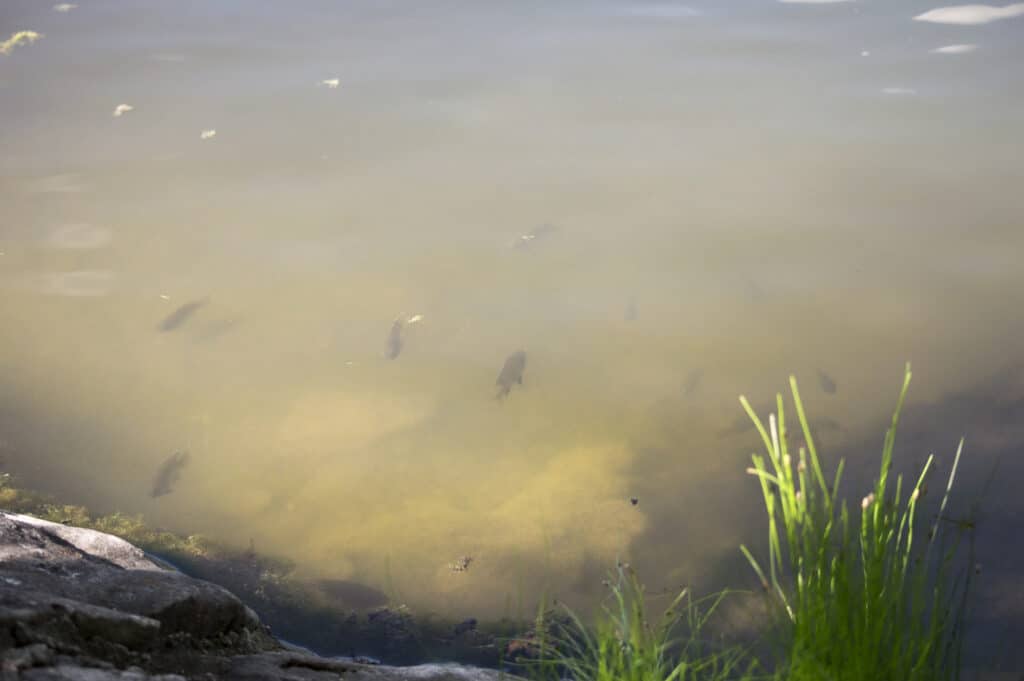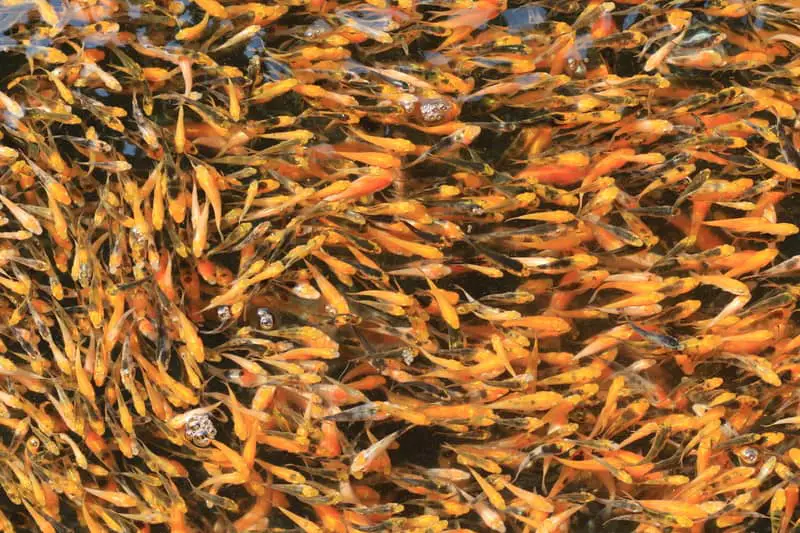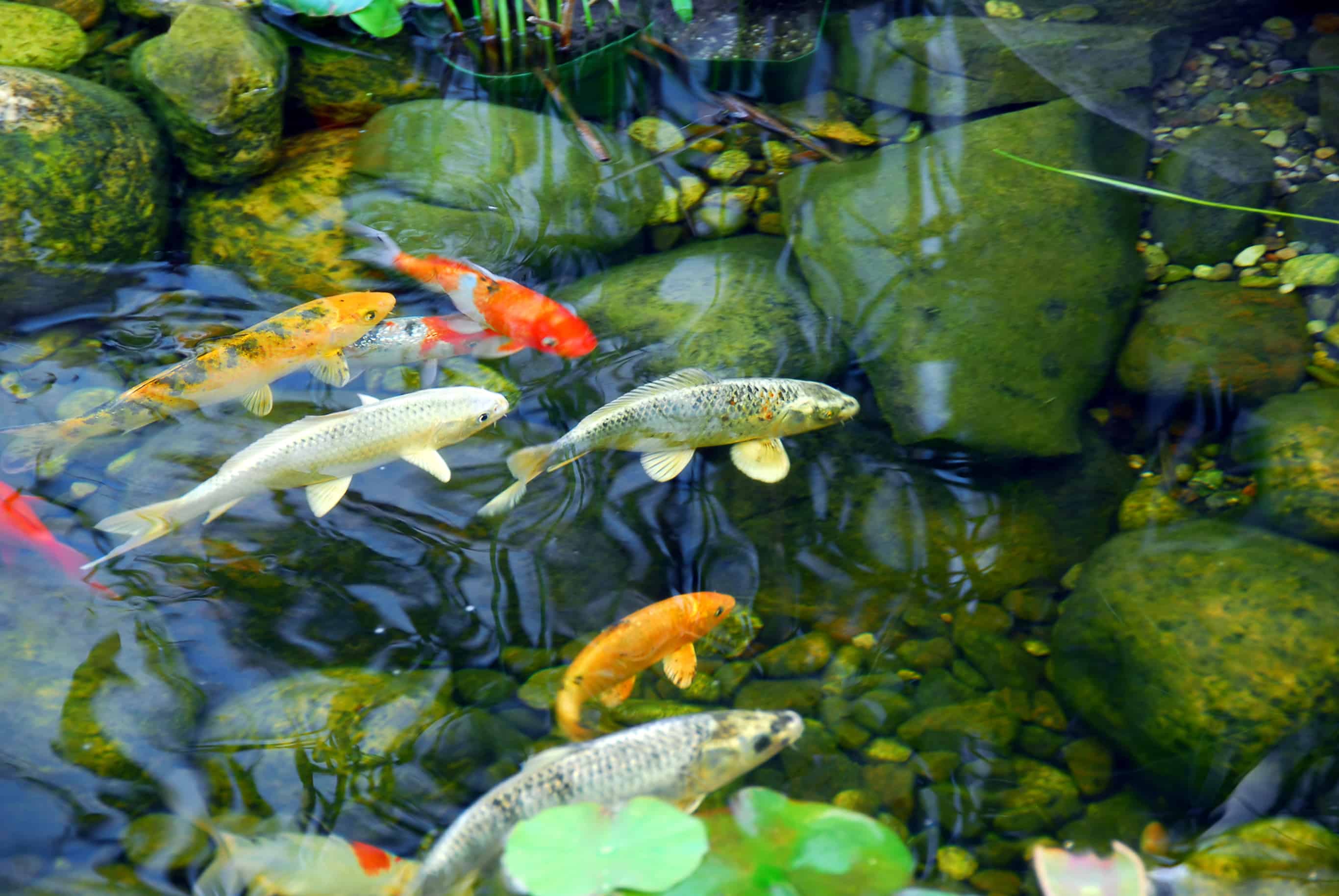
Building a garden pond is always accompanied by the vision of bubbling water and happy fish. Maintaining the water’s clarity, however, is more complex. Most pond owners will have to deal with cloudy water at some time. With that in mind, what are the causes of your koi pond’s cloudy, murky appearance?
Pond water may become cloudy for a multitude of reasons, including dead algae, fallen leaves, inadequate filtration, silt, a lack of oxygen, overfeeding your fish, and overpopulation in the pond, to name a few. For example, when there is an over bloom of algae, the water turns green and murky.
A cloudy koi pond could raise many concerns for new pond owners. Cloudy water makes it harder to observe fish and may indicate a rising water imbalance. Cloudy water may be a pain for pond owners since it makes it more challenging to view fish and gives the water a muddy look. That said, let’s take a further look into the causes.
Pro Tip: If you’re tired of wasting money and making costly mistakes on the koi-keeping hobby or are thinking about buying koi fish but don’t know where to start, I strongly suggest you check out this ebook. I recently read this ebook, and it contains SO much useful information, such as:
- 3 proven steps to identify koi fish diseases
- WARNING: 3 things you should NEVER do when it comes to caring for koi
- When to seek professional help when it comes to looking after your koi
Cloudy Koi Ponds And What Causes It
Almost every pond owner will eventually see brown or green water in their pond, and it may be highly unpleasant to those who are experiencing it for the first time. But unfortunately, it’s ubiquitous in koi ponds, and the only way to get rid of it is to figure out what’s causing it.
The Most Common Cloudy Koi Pond Cause: Dead Algae
Every pond has its own personality, and each one is distinct in some way. Even the most experienced pond owners find determining the cause of hazy pond water challenging. The most common cause of cloudy pond water is a planktonic algal bloom, which can occur for various reasons.
The water does not have to be green to suspect algae, especially if you employ an algae treatment. The plantlike creature dies once the live algae are treated. Therefore, a pond with dead algae may appear gloomy and mucky.
Filtration is required to clear cloudy pond water of this nature. You will recover more quickly if you clean your filter cartridge or media daily.
Poor Filtration Is A Common Result Of Cloudy Water
Filtration is essential in fish ponds, and cloudy greywater indicates that the filters are insufficient or not operating. Adding a biofilter pond next to it might help keep the water pure.
A biofilter circulates water through a second, shallow pond, where beneficial bacteria adhere to inorganic filtering media such as plastic beads or gravel to remove ammonia and nitrites from waste.
The cleansed water is then constantly recirculated back to the main pond. The filters will work better if the bottom is cleaned regularly to remove sludge build-up. The most straightforward strategy to deal with cloudy pond water is to avoid it in the first place. It cannot be overstated how crucial proper filtration is.
Don’t scrimp on this: Get the right filter for the amount of water you’re using, with the recommended turnover per hour ratio. Some pond owners may place a sheet of quilt batting around the filter input to speed up the cleaning process and remove small pollutants, checking and washing the batting regularly.
You may control algae with regular treatments. It will assist if you keep the pond out of direct sunshine. A thorough algae remover is a filter system with UV-C illumination.
Cloudy Water May Result From Falling Leaves
Pond water can become murky as a result of fallen leaves. If the pond is beneath a tree, the only way to keep it clean is to shovel falling leaves and other tree detritus every day. Pond skimmers and nets and those used in pools for the same reason are efficient instruments for the job.
As leaves and organic waste degrade, they make the water murky and deplete oxygen, which can be harmful to koi fish. Therefore, maintaining water quality also requires keeping the water well-oxygenated using a fountain, aerator, and oxygenator plants.
Koi Stools Contribute To Cloudy Water
Koi are animated fish who eat so quickly that it’s easy to lose count of how much food you’ve put in the water as they devour it. The pond water will get hazy if there is too much food.
It might be because the food has degraded into organic mush or because too much food color has leached out and tainted the water’s purity. In addition, too much food implies more fish waste and decaying uneaten food, which can cause water to become cloudy.
Reduce your food intake, and the issue will subside. Aquarists follow the guideline of feeding these fish as much as they can consume in three minutes.
Overcrowding Your Koi Pond

Fish have a high rate of growth and may reproduce quickly. Your two or three ornamental koi might grow to be 50 cm long in a few years and generate enough progeny to overpopulate their pond. Make a strategy to get rid of any surplus fish in the pond by gifting them to friends or distributing them to a local pet store.
To ensure the health of the fish you give away, you’ll need to devise a safe quarantine system. However, retaining them means that your pond will get overcrowded, the water will become cloudy, and the fish will be threatened due to bad pond conditions and strained immune systems.
Another simple technique to keep the number down is to cull the new fish before they mature. Then, at approximately a month old, keep the darker goldfish and the most robust koi.
Leaching Can Be Culprit To Cloudy Water
Often, new pond owners are in such a hurry to furnish their aquatic ecosystems that they don’t correctly inspect any modifications that have been made. So instead, purchase pond rocks and plants from a reliable pond vendor; pond rocks are frequently the gray hazy pond water source.
Before putting them in the water, clean them thoroughly and soak them. Sludge, talc, internal seepage, and sediments are all examples of rocks that release particles into the water. Soaking for a few days will help identify the features of the rocks. Plants in ponds grow and decay, and their emissions can muddy the water.
You may solve that problem by removing old plants, trimming down root systems, and ensuring sufficient filtering.
Deferred Clay May Cause Cloudy Water
Runoff from adjacent regions is likely to bring clay particles into the pond during rainstorms if the pond water is a murky brown hue. Because the clay particles are so minute, they may float in the water for an extended period.
Organic or chemical flocculants can aid in clumping clay particles, allowing them to sink more quickly. However, the best remedy is to keep runoff from entering the pond in the first place. You can channel dirty water away from the pond by digging a trench or planting a rain garden.
How To Clear Cloudy Water In Your Koi Pond

One of the most frustrating aspects of owning a backyard garden fish pond is not knowing what to do when the water turns muddy, green, and disgusting! Fortunately, keeping pond water pure using natural methods is straightforward, and you’ll be able to enjoy your pond again in no time.
This rapid cleaning process for pond water may work for you, whether it’s somewhat green or thick like swamp soup, where you can’t see the bottom and only catch glimpses of the fish.
While I’ve only tested it on ponds around 1000 gallons, it should work on more extensive ponds if you use a strong enough recirculating pump and give it enough time to filter all of the water. So, in other words, the larger and dirtier the pond, the longer it will take.
Within an hour or two of applying this procedure, a somewhat muddy 600-gallon pond will generally become significantly cleaner and will continue to clear. So, if you’ve tried everything else and failed, you could be in luck. With that in mind, let’s look at a few solutions.
Test The Water Quality
When your water becomes hazy, the first thing you should do is examine it for potential concerns. It is valid for both new and older ponds since both might have water quality concerns.
The difficulties with newer ponds that haven’t been adequately cycled before adding fish are frequently caused by excessive ammonia or a pH fluctuation.
In addition, ammonia levels begin to increase because there are no efficient mechanisms for eliminating waste in an uncycled fish pond due to a lack of beneficial microorganisms. On the other hand, it might be a mix of factors in mature ponds, and pinpointing the reason would be impossible without more investigation.
A water test kit is the best approach to see if you have an issue with water quality that creates murky water. These provide an “all-in-one” method of testing the most critical measurements, such as ammonia, pH, nitrites, and occasionally KH.
Most tests use ammonia as a reference measurement, and the desired value is as near to zero as feasible. Ammonia is unwanted in ponds; thus, the less of it, the better water clarity and fish health. Water pH should range from 6.5 to 8.5, but 6.8 to 7.8 is better for koi fish.
A low KH measurement, which measures dissolved bicarbonate and carbonate ions in pond water, is frequently the cause of an increase or decrease in pH. These work as pH buffers in your pond water, reducing abrupt pH shifts and promoting a more stable ecosystem.

Improve Your Filtration
Waste accumulation or free-swimming particles not being cleaned by your filter might be the source of murky or hazy water. Biological filtration breaks down organic debris and converts toxic ammonia to nitrites, subsequently converted to nitrates, which plants utilize.
Millions of helpful bacteria residing on your pond floor and inside your biological filter material carry out this procedure. However, your biological filtration may need to be improved if you may determine a build-up of waste and ammonia with a test kit.
It might be as easy as adding extra beneficial bacteria to the filter box, or it could necessitate a more advanced filter system or bio-media. It’s critical to make sure your filter box is the right size for your pond and bio-load (fish waste), and ponds with many fish may benefit from a larger filter.
If your filter box is the right size, introducing helpful bacteria to the pond or experimenting with a different type of bio media could be the best choice. Furthermore, tiny debris particles may be generating murky water, and your standard mechanical media may not be able to remove them.
Adding a fine media, such as poly-wool or durable polyester fibers, to your filter is an excellent technique to remove brittle particles and tannin (color) from pond water. If you have a pressurized filter, it’s best to put the poly-wool in a basket in front of the filter output, as the media can cause a lot of pressure to build up.
Once the media becomes blocked, you must replenish it until the required clarity is achieved, which might take several weeks, depending on the quantity of debris.
Control The Algae Growth In Your Koi Pond
You’re probably dealing with a bloom of green free-swimming algae if your pond water is hazy and somewhat green in color. Green algae, if left unchecked, will convert a pond into a thick green soup, causing a slew of problems for fish.
More significant algae, such as string algae, are less likely to influence water quality directly, but they can still be an annoyance in a garden pond.
Fortunately, green water algae may be readily eradicated using a UV clarifier and regular filter media maintenance. A clarifier is our preferred method of decreasing green algae since, unlike algaecides, it is harmless for fish and helps to eliminate hazardous free-swimming bacteria.
If your water starts turning murky and green, you won’t need to run the clarifier for long to notice a difference. The bloom may take a few weeks of continuous operation until the water clears if the bloom is exceptionally thick.
Make sure to clean your mechanical filter media regularly, regardless of how much algae you have! As the algae are destroyed by UV radiation, they will become trapped inside the filter box and block the media fast.
You may need to clean your pond daily until you observe a significant drop in green water or risk severely compromising your pond’s overall filtration.
You can add beneficial bacteria to aid in the decomposition of dead algae. In addition, extra aeration, such as an air pump, can be installed to assist the bacteria in operating more efficiently.
Conclusion
Koi are sturdy pond fish that may survive in less-than-ideal settings for a short period. But, on the other hand, the fish will be the healthiest and survive the longest in generally clear, clean water.
Therefore, it’s critical to discover the sources of cloudy and color-tinted water as soon as possible and how to attend to it to keep the pond alive.


